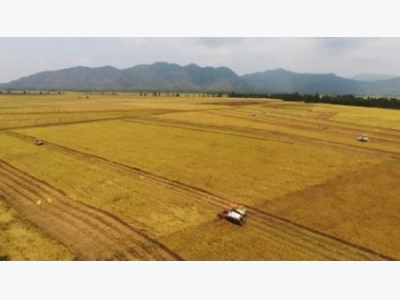Mekong Delta expands farm land toward large-scale production

Land concentration toward large-scale commodity production is one of the main objectives of Vietnam’s agriculture restructuring.
Farm land expansion in the Mekong Delta region has benefitted those involved in large-scale production models.
With 120 ha of farmland, Nguyen Van Khanh of Phu Cuong village is one of the largest individual landowners in Dong Thap province. Until recently his family farmed several small disconnected fields. Khanh has found ways to consolidate his farmland by renting the land from others to create large-scale production areas.
But Khanh says this is a band-aid solution. In the long run, he says, he hopes the government will promulgate a clearer policy on farmland expansion.
Khanh told VOV “With this model, we can mechanize agricultural production to increase efficiency. But we need clearer policies on the expansion of farm land so farmers can feel secure about their production.”
In Dong Thap, one of the Mekong Delta’s largest farm areas, the average farm household has about 1,440 square meters of farmland, which is usually divided into separated rice fields, making mechanization unfeasible. But lately some farmers and collectives, in expanding their farmland, have begun to develop larger-scale production models.
Le Minh Hoan, Secretary of the Dong Thap provincial Party Committee, said land expansion is an important lever for boosting production of farm commodities and changing farmers’ ways of thinking.
“We should find a way to get farmers to reach a consensus on farmland expansion and indemnify their risks. Dong Thap is trying to persuade farmers to expand their farmland or lease land to create larger-scale paddy fields,” said Hoan.
Farmland expansion began earlier in the Mekong Delta than elsewhere in Vietnam, but there have been lots of difficulties in affirming ownership of the land.
Huynh Van Thon, Director General of the Loc Troi Group, a leading distributor and manufacturer of crop protection chemicals in Vietnam, said farmland expansion has made it easier to mechanize production and apply modern technology and farming techniques.
Thon said that in recent years a growing number of farm households have joined his group’s large-scale rice field model. For the first winter-spring crop of the 2010-2011 period, the model was applied to about 1,000 ha. That figure had grown to more than 90,000 ha by 2015.
He said “I hope the government can convince the National Assembly to increase farmers’ land ownership and allow them to expand their fields. That will foster large-scale production and mechanization and modernize Vietnam’s agriculture.”
According to the Steering Committee for the Southwest Region, the large-field model has cut production costs 10% to 15% and increased production values 20% to 25%, boosting farmers’ profits to US$330 per hectare.
Có thể bạn quan tâm
 Vinh Long rice farmers go organic, reap rewards
Vinh Long rice farmers go organic, reap rewards Nguyễn Hữu Phước of Hamlet 9 in Mỹ Lộc Commune in Vĩnh Long Province, grows organic rice on 7,000sq.m of land.
 Forum discusses developing agricultural products’ labels, brands
Forum discusses developing agricultural products’ labels, brands The agricultural sector has eight products earning over one billion USD from exports, namely coffee, rubber, rice, aquatic products, cashew nuts, peppers, fruit
 Promoting Vietnam’s green brand names
Promoting Vietnam’s green brand names To catch up with the trend of sustainable development, managers and businesses have to develop national brand names of green products.